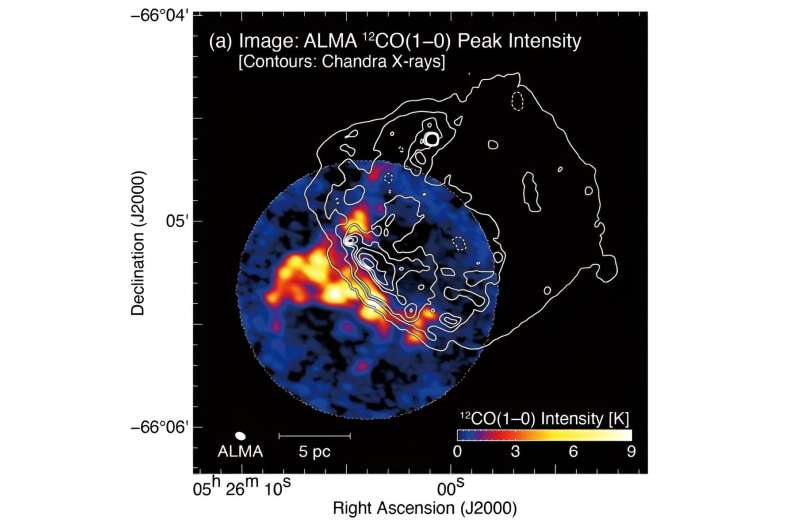November 14, 2023 report
This article has been reviewed according to Science X's editorial process and policies. Editors have highlighted the following attributes while ensuring the content's credibility:
fact-checked
preprint
trusted source
proofread
ALMA observations shed more light on molecular clouds associated with supernova remnant LHA 120-N49

Using the Atacama Large Millimeter/Submillimeter Array (ALMA), an international team of astronomers has observed a supernova remnant known as LHA 120-N49. Results of the observational campaign, published November 3 on the pre-print server arXiv, provide crucial insights into the nature and properties of molecular clouds associated with this remnant.
Supernova remnants (SNRs) are diffuse, expanding structures resulting from a supernova explosion. Observations show that SNRs comprise expanding material that was expelled during the explosion, as well as interstellar matter collected as it was swept up by the shockwave produced by the exploded star.
Studies of supernova remnants are important for astronomers, as they have a crucial impact on the evolution of galaxies, dispersing the heavy elements made in the supernova explosion and providing the energy needed for heating up the interstellar medium. Moreover, SNRs are assumed to be responsible for the acceleration of galactic cosmic rays.
LHA 120-N49 (or N49) is a bright X-ray supernova remnant in the Large Magellanic Cloud (LMC) with an apparent diameter of about 59 light years. The remnant has an age of about 4,800 years and its explosion energy is estimated to be at a level of 1.8 sexdecillion erg.
Previous observations have found that the environment of N49 contains molecular clouds and young stellar clusters. It appears that the shockwave from the SNR is interacting with dense clumpy interstellar clouds on the remnant's eastern side. Recently, a team of astronomers led by Hidetoshi Sano of the Gifu University in Japan, decided to employ ALMA to investigate this interaction.
"We carried out observations of 12CO(J = 3–2) emission line using the ALMA Atacama Compact Array Band 7 in Cycle 8. We used 10–11 antennas of the 7-m array in 2022 August 22, 27, 30, and September 2. We also used 3–4 antennas of the Total Power (TP) array in 2022 August 2, 4, 7, 8, 13, 17, 18, 20, and 27," the researchers explained.
ALMA observations have revealed clumpy distributions of molecular clouds associated with N49. The clouds appear to completely delineate the southeastern edge of the remnant's shell and show a high-intensity ratio of the investigated emission lines. This suggests that shock-cloud interactions have occurred.
In total, eight molecular clouds have been identified in the vicinity of N49. The kinetic temperature and number density of molecular hydrogen of these clouds further indicate that they were caused by supernova shocks. The astronomers noted that this is the first evidence of shock-heated molecular clouds in an extragalactic supernova remnant.
The study also found that five molecular clouds have constant pressure and did not experience shock evaporation within the existence of N49. The other three most likely partially evaporated through the shock-cloud interaction.
More information: Sano et al, ALMA Observations of Supernova Remnant N49 in the Large Magellanic Cloud. II. Non-LTE Analysis of Shock-heated Molecular Clouds, arXiv (2023). DOI: 10.48550/arxiv.2311.02180
Journal information: arXiv
© 2023 Science X Network





















